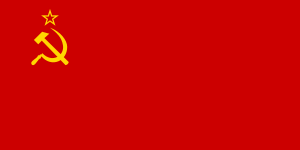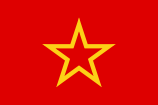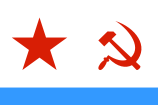- Flag of the Soviet Union
-
"Flag of the USSR" redirects here. For other uses, see Flag of the USSR (disambiguation).
Flag of the Soviet Union
Name The Red Banner[1] Use Civil and state flag and ensign 

Proportion 1:2 Adopted November 12, 1923 (original version)
August 15, 1980 (last version used)
Design A plain red flag with a golden hammer and sickle and a gold-bordered red star in its upper canton. 
Variant flag of the Soviet Union Use War flag 

Proportion 2:3 Design plain red flag with a large red star edged yellow 
Variant flag of the Soviet Union Use Naval ensign 

Proportion 2:3 Design A white flag with a red star, hammer and sickle with a blue strip below. The flag of the Soviet Union consisted of a plain red flag, with a setting or cross-peen hammer crossed with a sickle (the hammer and sickle) and a red star in the upper canton. The hammer and sickle symbolized the nation's workers and peasants while the red star represented the rule of the Communist Party.
The first flag with the red star, hammer and sickle was adopted on November 12, 1923. In 1955, a statute on the flag was adopted which resulted in a change of the hammer's handle length and the shape of the sickle. A final modification to the flag was adopted in 1980 in which the color was brightened to light red. The flag continued to be a national flag until the dissolution of the Soviet Union.
Contents
Symbolism and design
The color red has always been a positive symbol in the Russian culture. The word red (Russian: красный, krasny) is etymologically related with the Russian word beautiful. This can also be seen in Moscow’s Red Square and the Russian Orthodox festivity, Red Easter.
The red field symbolizes the blood that has been spilled by workers and farmers. It honors the red flag of the Paris Commune of 1871.[2] The ideology of communism can be seen from the flag. The red star and hammer and sickle represent communism and socialism. The flag of the Soviet Union consisted of a plain red flag with a gold hammer is crossed with a gold sickle which are placed beneath of a gold-bordered red star. This symbol is then placed in the upper left canton of the red flag.
The hammer symbolizes the nation's industrial workers (proletarians) while the sickle symbolizes the nation's agricultural workers (peasants)—who together formed the state. The red star represented the rule of the Communist Party. The back side of the flag is officially just red, without the symbols. However, in practice, the flag was usually made through and through and thus the symbols usually appeared on the reverse side and in the reverse order.[3]
The flag's design was statuted in 1955, which gave a clear way to define and create the flag. This resulted in a change of the hammer's handle length and the shape of the sickle. The adopted statute stated that:[4]
- The ratio of width to length of the flag is 1:2.
- Hammer and sickle are in a square with sides equal to ¼ of the flag height. Sharp tip of the sickle lies in the center of the upper side of the square, handles of hammer and sickle rest in bottom corners of the square. Length of the hammer and its handle is ¾ of the square diagonal.
- Five-pointed star is inscribed into a circle with a diameter of ⅛ of the flag height, the circle is tangent to the upper side of the square.
- Distance of the vertical axis of star, hammer and sickle from the flagstaff is ⅓ of the flag height. Distance from the upper side of the flag to the center of the star is ⅛ of the flag height.
The final design of the flag was adopted in 1980. The design was kept the same except that the background color was changed. The color was brightened from a near-burgundy crimson to a light to medium red.
History
During the establishment of the Russian SFSR, Vladimir Lenin and his colleagues had considered the inclusion of a sword symbol in addition to the hammer and sickle as part of the state seal on which the flag was eventually based. The idea was dismissed as too visually aggressive. Lenin apparently said "A sword is not our symbol."[5]
The first official flag was adopted in December 1922 at the First Congress of Soviets of the USSR. It was agreed that the red banner 'was transformed from the symbol of the Party to the symbol of a state, and around that flag gathered the peoples of the soviet republics to unite into one state — the Union of Soviet Socialist Republics'. On December 30, 1922, the Congress adopted a Declaration and Agreement on the establishment of the USSR. Article 22 of the Agreement states: 'the USSR has a flag, coat of arms and a state seal.' The description of the first flag was given in the 1924 Soviet Constitution, accepted in the second session of the Executive Committee (CIK) of the USSR on July 6, 1923. The text of article 71 states: 'The state flag of the Union of Soviet Socialist Republics consists of a red or scarlet field with states coat of arms'. It was ordered with the unusual ratio of 4:1 in proportion and consisted of a red flag with the state coat of arms in the center. However, such a flag was never mass produced. This flag was the official flag for four months, and was replaced as the official flag by the more familiar hammer and sickle design during the third session of the CIK of the USSR on November 12, 1923.
In the third session of the CIK of the USSR, the description of Soviet flag in the Constitution was changed, and article 71 was edited to be: 'The state flag of the Union of Soviet Socialist Republics consists of a red or scarlet field, and in the canton a golden sickle and hammer, and a red five-pointed star bordered in gold above them. The ratio of width to length is 1:2.' On August 19, 1955 "Statute on the State Flag of the Union of Soviet Socialist Republics" was adopted by a decision of the Presidium of the Supreme Soviet of the USSR. This resulted in a change of the hammer's handle length and the shape of the sickle. A final modification to the flag was adopted on August 15, 1980, which changed the flag field into a bright red. These modifications stayed into use until the disintegration of the USSR on 25 December 1991, in which the flag ceased to be a national flag.
Similarities with other flags
The Soviet Union was the first country to form a communist government, making it the inspiration of future socialist states. This led to the inspirations for the flags of Angola, the People's Republic of China, North Korea, Vietnam (North Vietnam) and the Socialist Federal Republic of Yugoslavia.
The flags of the Soviet republics that constituted the USSR were all defaced versions of the Soviet flag.
On April 15, 1996 Boris Yeltsin signed a presidential decree giving the Soviet flag (called the Victory Banner, after the banner that was raised above the Reichstag on May 1, 1945) status similar to that of the national flag. The difference is that the hammer and sickle has been removed from the flag. On certain holidays, the Victory Banner is flown along with the Russian flag. Under President Putin, the Victory Banner was adopted as the official flag of the Russian Army.[citation needed]
-
The flag of People's Republic of Benin
-
The flag of SFR Yugoslavia
-
The flag of North Korea
-
The flag of South Yemen
-
The flag of People's Republic of China (adopted in 1949)
-
flag of Khmer Rouge Cambodia
-
The Flag of the Shining Path
See also: Flags of the Soviet RepublicsSee also
- List of USSR navy flags
- Flag of the People's Republic of China
- Flags whose reverse differs from the obverse
- Hammer and Sickle
- Red Star
References
- ^ Whitney Smith (2008). "Flag of Union of Soviet Socialist Republics". Encyclopædia Britannica. http://www.britannica.com/eb/article-9125227/Union-of-Soviet-Socialist-Republics-flag-of. Retrieved 2008-11-05.
- ^ "Story of the Red Flag", Revolution, 05-19-2006. Retrieved 12-02-2007.
- ^ Victor Lomantsov (2002-11-30). "Reverse of the flag". FOTW.net. http://www.fotw.net/flags/su.html#rev. Retrieved 2008-11-05.
- ^ USSR Supreme Soviet Presidium (19 August 1955). "Положение о государственном флаге СССР" (in Russian). http://pravo.levonevsky.org/baza/soviet/sssr6212.htm. Retrieved 2008-11-05.
- ^ Konstantin Andreevich Ivanov (1971) (in Russian). Flags of the states of the world. Moscow: Izd-vo Transport. p. [page needed]. OCLC 20146023.
External links
 Flags of the Soviet Union and Soviet Republics
Flags of the Soviet Union and Soviet RepublicsFlag of the Union of Soviet Socialist Republics (USSR)
Armenian SSR · Azerbaijan SSR · Byelorussian SSR · Estonian SSR · Georgian SSR · Karelo-Finnish SSR (1940–1956) · Kazakh SSR · Kirghiz SSR · Latvian SSR · Lithuanian SSR · Moldavian SSR · Russian SFSR · Tajik SSR · Transcaucasian SFSR (1922–1936) · Turkmen SSR · Ukrainian SSR · Uzbek SSR Categories:
Categories:- Flags of the Soviet Union
- Obsolete national flags
- National symbols of the Soviet Union
Wikimedia Foundation. 2010.

















